
This application note outlines the performance benefits achieved with UCT’s LipiFiltr® cleanup cartridge for the analysis of pesticides in oil-based cannabis products using LC–MS/MS analysis.

This application note outlines the performance benefits achieved with UCT’s LipiFiltr® cleanup cartridge for the analysis of pesticides in oil-based cannabis products using LC–MS/MS analysis.
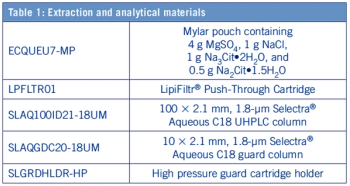
The easy to use, new LipiFiltr® push-through purification cartridge was designed to remove lipids from acetonitrile extracts. This application will outline the performance benefits achieved using the new LipiFiltr® cartridges in applications involving multiclass, multiresidue analysis for pesticides in complex, high fat samples.
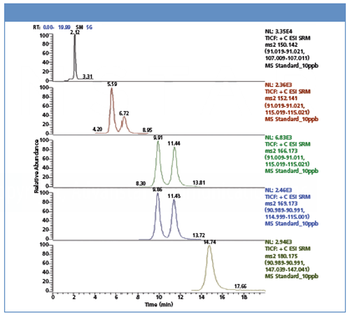
Ephedra alkaloids are phenethylamines that occur naturally in plants, including the herb Ma Huang used in traditional Chinese medicine. Ephedra alkaloids are potent CNS stimulants and also have a sympathomimetic effect on the peripheral nervous system. The aim of this study was to develop a multi-analyte procedure for the extraction, cleanup, and quantification of the ephedra alkaloids in functional foods and natural products. High capacity strong cation-exchange SPE cartridges were used for the isolation of ephedrine, pseudoephedrine, norephedrine, norpsuedoephedrine, methylephedrine, and synephrine from dietary supplements.

Research scientists in the cannabis field are tasked with validating robust methods that can be seamlessly transitioned into production laboratories. Unlike typical disciplines where controls are easily (and legally) obtained through known manufacturers, analytical chemists working for both consumable vendors as well as cannabis laboratories must do their best to develop methods often without such resources at their disposal. As the industry matures and additional regulations are adopted, the evolution of the pesticide testing subsection continues to be vastly different depending on the jurisdiction one does business in. This creates an interesting challenge for commercial scientists tasked with developing methods that will appeal to a majority of their consumers, while also generating unexpected hurdles to said laboratories once the methods are placed into production. Ace Analytical Laboratory, located in Las Vegas, Nevada, has successfully adopted and validated pesticide testing methods for their cannabis laboratories and has gained valuable insight into how to best work with such a difficult matrix. In conjunction with UCT, LLC, an overview of best practices and method development techniques for pesticide testing in cannabis is discussed below and told from a technical perspective.
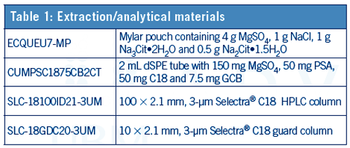
This application note outlines a simple, fast, and cost‑effective QuEChERS-based method for the determination of limonin in citrus juice. Limonin is extracted from a variety of juice samples using acetonitrile and citrate-buffered salts. The sample extract undergoes cleanup by dispersive-SPE (dSPE) using primary‑secondary amine (PSA), C18, and graphitized carbon black (GCB) to remove unwanted matrix components, including sugars, acids, and pigments, and to yield a clear sample extract. Analysis is performed by liquid chromatography coupled to tandem mass spectrometry (LC–MS/MS) using a Selectra® C18 HPLC column (although high performance liquid chromatography [HPLC]–UV can also be used).

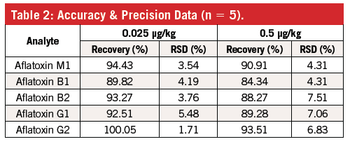
Aflatoxins (B1, B2, G1, and G2) are naturally occurring mycotoxins produced by fungi on agricultural crops. They are classified as carcinogenic and can pose a significant risk to human health if consumed. Although aflatoxin B1 is the most potent carcinogen, the main concern in milk is its hydroxylated metabolite, aflatoxin M1. To ensure the safety of milk, the US FDA established a tolerance of 0.5 µg/kg for aflatoxin M1 in milk, while the EU set a limit of 0.05 µg/kg in raw milk and 0.025 µg/kg in infant formula. A simple and effective method using polymeric solid-phase extaction (SPE) and liquid chromatography coupled to tandem mass spectrometry (LC–MS–MS) is presented for the analysis of aflatoxins in milk at the low concentrations required.
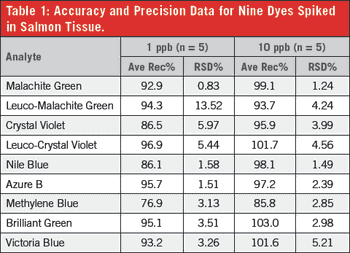

LCGC NA - Determination of Hormones in Water by Solid-Phase Extraction (SPE) and Liquid Chromatography ? Tandem Mass Spectrometry (LC-MS/MS)

UCT Application Note
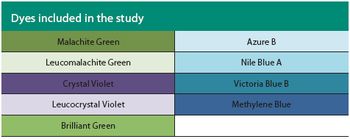
UCT Application Note

The level of pollutants present in water bodies is most commonly judged against set environmental quality standards (EQSs) that vary among different countries.

Published: March 20th 2013 | Updated:

Published: December 2nd 2012 | Updated:
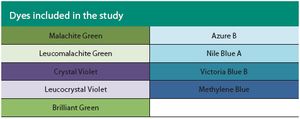
Published: March 2nd 2012 | Updated:

Published: February 22nd 2012 | Updated:

Published: March 2nd 2014 | Updated:

Published: July 1st 2015 | Updated: